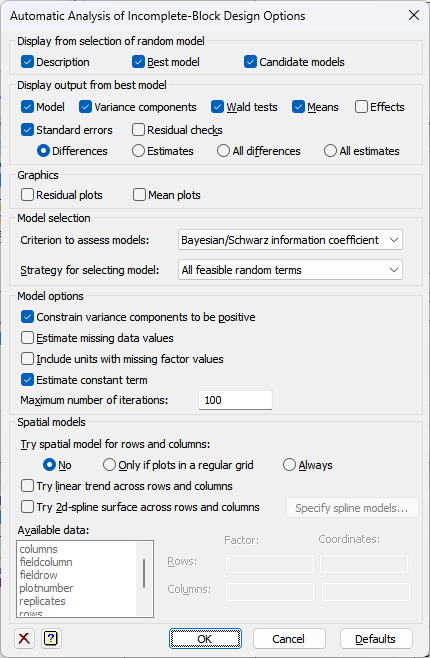Selects information to be printed by the analysis and controls certain aspects of the method used.

Display from selection of random model
This specifies which items of output are to be produced by the analysis.
| Best model | A description of the best model found. |
| Candidate models | A summary of each candidate model tried. |
Display output from the best model
This specifies which items of output are to be produced by the analysis using the best fitting model.
| Model | Description of the model fitted by the analysis. |
| Variance components | Estimates of variance parameters. |
| Wald tests | Wald tests for fixed model terms. |
| Means | Predicted means. |
| Effects | Estimates of effects for the fixed effects. |
| Standard errors | Estimates of standard errors for means or effects. |
| Residual checks | Uses the VCHECK procedure to check the residuals for outliers and variance stability |
Standard errors
Tables of means and effects can be accompanied by estimates of standard errors if selected above. You can choose whether Genstat computes standard errors or standard errors of differences (SEDs) for the tables giving all values or just a summary of these.
| Differences | Display the minimum, mean and maximum standard errors of differences between means or effects. |
| Estimates | Display the minimum, mean and maximum standard errors of estimates for means or effects. |
| All differences | Display all the standard errors of differences between pairs of means or effects. |
| All estimates | Display all the standard errors of estimates for means or effects. |
Criterion to assess models
This specifies the criterion to use to select the best random model.
| Akaike information coefficient | Take the model with the smallest value of the Akaike information coefficient. |
| Bayesian/Schwarz information coefficient | Take the model with the smallest value of the Bayesian or equivalently the Schwarz information coefficient. |
Strategy for selecting model
This specifies the strategy for selecting the random model.
| All random terms | Fits the full random model. This is appropriate if the blocking factors played a key role in the design and its randomization. |
| All feasible random terms | Tries to fit the full random model. If this is not possible, it tries models removing first one random term, then two and so on, until successful. |
| Best possible random model | Tries all feasible random models and takes the best one. |
Constrain variance components to be positive
This specifies whether the variance components are constrained to be positive.
Estimate missing data values
This specifies whether predictions are formed from the fitted model for missing values of the y-variate.
Include units with missing factor values
This specifies whether data units with missing values in any of the factors in the fixed or random models are included in the analysis.
Estimate constant term
Specifies whether a constant term is included in the fixed model.
Maximum number of iterations
Specifies the maximum number of iterations that can be used by the REML analysis to converge to a solution.
Try spatial model for rows and columns
This specifies whether spatial correlation models are tried with the row and column effects.
| No | Do not fit a spatial model. |
| Only if plots in a regular grid | A spatial model will be fitted, if the plots form a complete grid of rows x columns within each replicate. |
| Always | Always fit a spatial model. |
For a regular grid, when a spatial model is being fitted, the analysis tries models with order 1 auto-regressive structures on the rows and/or the columns of the design, provided there are more than four rows or columns, respectively. For an irregular grid, if there are more than four rows and more four columns, it tries an anisotropic power-distance model using city-block distance. Otherwise, if there is only one dimension with more than four coordinates, it tries an isotropic power-distance model. Unless No is selected you must provide row and column factors.
Try linear trend across rows and columns
This specifies whether to investigate if linear row and column trends (i.e. covariates) are needed in the fixed model. If this is selected you must provide row and column coordinates.
Row factor
An optional factor specifying the rows in the layout. If Try spatial model for rows and columns is selected, this is required.
Row coordinates
An optional variate or factor specifying the spacing of rows. If the layout is irregular or a linear trend is being tried, this must be specified.
Column factor
An optional factor specifying the columns in the layout. If Try spatial model for rows and columns is selected, this is required.
Column coordinates
An optional variate or factor specifying the spacing of columns. If the layout is irregular or a linear trend is being tried, this must be specified.
Available data
This lists data structures appropriate to the current input field. The contents will change as you move from one field to the next. Double-click on a name to copy it to the current input field or type the name.
See also
- Automatic Analysis of Incomplete-Block Design menu.
- Further Output for additional output after fitting a model.
- Save for saving the results from the analysis.
- REML Predictions dialog for forming predictions.
- VABLOCKDESIGN procedure for automatically fitting the incomplete-block model using command mode.
- VCHECK procedure to check the residuals.